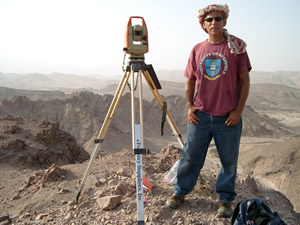
Tom Levy surveying for archaeological sites in Southern Jordan.
These days, most people’s knowledge of archaeology is based on Harrison Ford’s epic adventures as Indiana Jones. But does the reality remotely resemble what’s on the screen? If anyone should know, it would be Tom Levy, a professor of Anthropology at UC San Diego and a distinguished field archaeologist who was recently named a Fellow of the prestigious American Academy of Arts and Sciences.
“I think every real ‘dirt’ archaeologist fancies him or herself as an Indiana Jones-type character,” posits Levy, who holds the Norma Kershaw Endowed Chair in the Archaeology of Ancient Israel and the Neighboring Lands at UCSD. “During our excavations, we carry out state-of-the-art research, but we still have a lot of adventures. Just ask my students!”
It was the lure of these kinds of adventures that first sparked Levy’s interest in anthropology as a young boy growing up in Los Angeles. His mother had decided to go back to college and the family became friends with a professor named Council “Count” Taylor, an anthropologist who worked in West Africa.
“Count would visit our home quite often and talk about his fieldwork in Africa,” Levy recalls. “As a 12-year-old, I was mesmerized by his stories and decided to become an anthropologist.”
A few years later, Levy had the opportunity to volunteer for a UCLA archaeological dig in the Santa Monica Mountains, an experience that he says “hooked” him on archaeology. He pursued the field as an undergraduate at the University of Arizona and went on to receive his Ph.D. in Archaeology from the University of Sheffield in England.
After completing his doctorate, Levy worked in Israel for many years conducting field work in the Negev desert and serving as assistant director of the W.F. Albright Institute of Archaeological Research and the Nelson Glueck School of Biblical Archaeology at the Hebrew Union College. He left Israel to join UC San Diego’s Department of Anthropology in 1992 where he served as chair and later became the director of the university’s Judaic Studies Program.
“UC San Diego is one of the world’s best research universities,” says Levy. “Through my teaching and research, I hope to raise the profile of Anthropology, Judaic Studies and the application of digital technologies to Archaeology at UCSD to one of the best in the country.”
His research efforts over the years have focused primarily on the evolution of complex societies, especially chiefdoms and ancient states, in the southern Levant—the area comprising Israel, Palestine, Jordan, Lebanon, Syria and the Sinai Peninsula—and the role of technology in the evolution of ancient cultures. He has published widely on these topics and in 2007 he served as the guest curator for the San Diego Museum of Man’s exhibition “Journey to the Copper Age” carried out in association with the National Geographic Society.
“I’m fascinated by how societies cross the threshold from egalitarian foragers and hunters to the first hierarchical societies,” he says. “I’m especially interested in the Middle East because it’s an area of so many ‘firsts’ in culture change—from the domestication of plants and animals to the rise of chiefdoms and the advent of new technologies like metallurgy.”
Levy’s interest in technology also extends to modern applications of digital technologies and media for archaeological research. He was recently appointed the associate director for Archaeology at UC San Diego’s new Center for Interdisciplinary Science for Art, Architecture and Archaeology (CISA3), which uses and develops technology to reconstruct and analyze archaeological sites and artifacts as well as great works of art and architecture. CISA3 is a part of the California Institute of Telecommunication and Information Technology (Calit2) at UCSD.
His enthusiasm for technology and its uses is rather ironic given the fact his colleagues often refer to him as a “dinosaur.”
“I’m one of the last Near Eastern archaeologists working in Israel and Jordan to still run expeditions out of remote tent camps in the desert,” he admits. “I guess that’s another thing Indiana Jones and I have in common.”
Fortunately for Levy—and unlike Indiana Jones—he gets to bring his wife on all his expeditions. Tom and Alina Levy travel together to the Middle East as well as India, where Levy conducts ethnoarchaeological field work on how material culture relates to traditional societies.
“I have found India to be one of the richest tapestries of contemporary culture where so many craft traditions continue in vibrant ways,” he says. “Of course, I’m lucky because Alina and her family have their roots in India so when we go on family visits I can also conduct research.” Levy’s work in India focuses on the traditional bronze casters of south India and is part of Calit2’s India initiative.
When he’s not out in the field, Levy can be found in the classroom or lab sharing his love of archaeology. Many of his undergraduate students have been accepted into the best graduate programs in the country and go on to become professional archaeologists. Levy was not able to teach at UCSD this past quarter as he was conducting research at the University of Bergen in Norway, but he is looking forward to working with students again.
“My favorite part of teaching is training students to become professional scholars,” he says. “Being able to involve students in my research is one of the most enjoyable aspects of my job.”
|